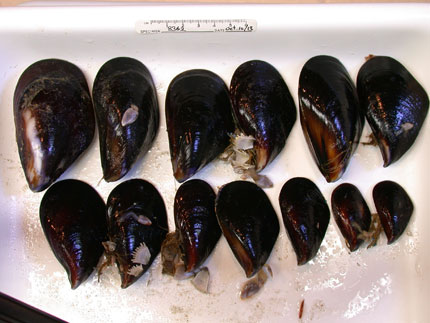
Genetic testing showed 13 mussels removed from the hull of a Japanese fishing boat that washed up on Vancouver Island in 2013 represented two different species.
Source: Gary Meyer, Fisheries and Oceans Canada
As global travel and trade continues to grow, so does the risk that more and more alien and invasive species will find their way to Canada.
Defending Canada against alien invasive species is an ongoing priority for government at all levels, and understandably so — from microscopic pathogens that infect our food crops to insects that ravage urban forests and aquatic plants that destroy fish habitat, the damage caused by foreign invaders to Canada is now measured in the tens-of-billions of dollars a year.
Increasing our understanding of how these potentially devastating pests and pathogens travel and where they come from is critical to assembling an effective defence.
Multi-department effort
Dr. Patrice Bouchard, a research scientist at Agriculture and Agri-Food Canada, coordinates a major research project being funded by the Government of Canada's Genomics Research and Development Initiative (GRDI). The Quarantine and Invasive Species (QIS) project brings together the research expertise and resources of a number of federal departments and agencies in applying science of genomics to develop new, faster and more accurate ways to detect, identify and trace the origin of alien and invasive species.
"Part of this effort is pathway analysis" says Dr. Bouchard, "Using genomics not only to identify alien species, but to help us figure out how these organisms can travel to Canada — information that can help our regulatory agencies target their resources to where the threat is greatest."
Alien species follow many routes
Some of these pathways are well-known — insects arriving from abroad in untreated wooden packing crates, for example — others can be somewhat surprising.
In October 2013, a six-metre fishing boat washed up on a beach on Vancouver Island. From the faded lettering on the side, it was apparent the boat represented a small part of the horrific impact of the tsunami that struck Japan in March 2011. Like so much other debris, winds and currents had carried it across the Pacific to the coast of North America.
Noticing the boat's hull was encrusted with barnacles and other forms of sea life, a sharp-eyed beachcomber reported the find to Fisheries and Oceans Canada (DFO).
Invaders identified
Using multi-gene DNA sequencing, DFO research scientist Dr. Cathryn Abbott was able to quickly identify several of the mussels clinging to the hull as a species native to the Korean peninsula, never before found in North America.
"We don't believe this particular species poses a high risk," says Dr. Thomas Therriault, DFO's lead aquatic invasive species scientist in the Pacific region. "Although it is known to hybridize, so there could be a slight risk to aquaculture on the B.C. coast, where there are a number of commercial mussel farms."
Is it one of ours?
"Perhaps more significant is how quickly we were able to identify this as a non-native species," says Dr. Abbott. "Many species of mussel are very similar in appearance. From a morphological point-of-view — looking at them — it is often difficult to tell a potentially invasive outsider from a native species. "
Dr. Abbott says GRDI funding was a key piece in identifying the mussel. "Without this funded project, we would not have had the resources or the readiness to do this work."
"The QIS project has enabled us to work with other federal departments and agencies in building a database of DNA sequences from specimens archived in biological collections," says Dr. Abbott. "All of these DNA sequences are traceable back to the specimen from which they were taken. Combined with the information about when and where and how each specimen was collected and the morphological data for each specimen, the DNA sequence allows a high degree of precision when it comes to identifying a species. Populating the database with DNA sequences from native Canadian species is essential to distinguish them from invaders."
A cautionary tale
While the mussel that arrived on the fishing boat may be considered a low-level threat, it is a member of a genus of mussels known for their ability to establish populations in non-native areas. The QIS Project Coordinator Dr. Bouchard says it is still worthy of note. "This is an example of how genomics enhances our ability to detect alien species with speed and accuracy," says Dr. Bouchard. "The earlier we can detect and identify alien species, the earlier we can take steps to manage the risk."
"It also validates the increased surveillance we undertook shortly after the tsunami hit," says Dr. Therriault. "In collaboration with the U.S. National Oceanic and Atmospheric Administration, we started tracking what we considered high-risk debris — boats and other things that were in the water when the wave hit and that could carry alien species like these mussels to North American waters. And it's not just tsunami debris — any sea-borne debris could bring alien species to Canada, so this is another pathway to think about."